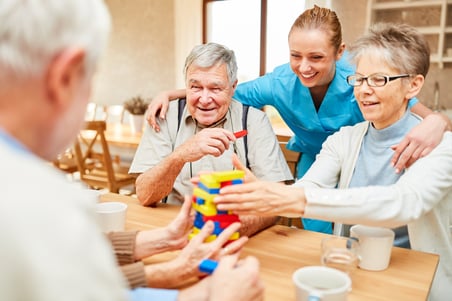By Shane Kuhnen, HHS Director, Housekeeping & Culinary, Senior Living
When day-to-day tasks such as housekeeping or cooking become a burden for the older generation, a difficult decision may arise. Whether that decision is made by the individual themselves or their family members, moving into a retirement community can be a big adjustment. This leaves team members in senior living communities well-positioned to step in to make the transition and experience easier on the residents and their families. Unlike hospitals, where individuals are constantly coming and going and room set ups and menus are consistent, continuing care retirement communities (CCRC) require a more tailored level of service. The reason behind the more specialized services is that all the residents—no matter their background, needs, and wants—have something in common. That common thread is that they call their CCRC home.
Service Built on Establishing Relationships
 The level of service in CCRCs needs to be built on establishing strong relationships. Team members have the opportunity to get to know the residents they’re serving since they are with them every day over the course of potentially many years. To build relationships, start by making time for meaningful conversations. As you listen, take note of details, whether that’s remembering the names of the resident’s children or grandkids or their favorite memories or music—it’s important to attentively listen and provide camaraderie. Take it a step further, and encourage employees to go out of their way to remember specific details. This tactic helps to show residents that their team genuinely cares for them as a person. This level of care creates strong bonds and plays a vital role in resident wellness. At the end of the day, wellness of the mind is just as important as wellness of the body. Initiating these types of relationship building skills can help ease the transition and makes residents feel comfortable.
The level of service in CCRCs needs to be built on establishing strong relationships. Team members have the opportunity to get to know the residents they’re serving since they are with them every day over the course of potentially many years. To build relationships, start by making time for meaningful conversations. As you listen, take note of details, whether that’s remembering the names of the resident’s children or grandkids or their favorite memories or music—it’s important to attentively listen and provide camaraderie. Take it a step further, and encourage employees to go out of their way to remember specific details. This tactic helps to show residents that their team genuinely cares for them as a person. This level of care creates strong bonds and plays a vital role in resident wellness. At the end of the day, wellness of the mind is just as important as wellness of the body. Initiating these types of relationship building skills can help ease the transition and makes residents feel comfortable.
Tailored Services for Each Individual
In CCRCs, services should be focused on ensuring residents feel at home. Ultimately, team members are cleaning someone’s home and ensuring their meals meet their specifications. The housekeeping and dining staff need to note resident preferences, make sure their unique needs are met, and ensure that they feel seen and cared for daily. For example, we may know that Mrs. Jones wants her beauty products organized precisely the right way on her bathroom counter, while Mr. Smith likes the trash can to be placed below the towel rack rather than next to the vanity. And when it comes to mealtime, we know that Mrs. Jones loves fresh and colorful salads while Mr. Smith would prefer a chicken fried steak and mashed potatoes. Whatever the dining preferences may be, it’s critical to ensure all residents are dining with dignity. Everyone, whether they are on a special or pureed diet, should always receive fresh never frozen food. CCRC team members should strive to remove the burden from the residents and make sure their home is kept and their meals are prepared just as they would do for themselves. An easy way to guarantee preferences are met is to keep a log that notes each individual's requests. This helps to ensure that residents are receiving the tailored services they would have provided themselves at their own home.
Making the decision for an individual to move into a CCRC is never easy. That’s why it’s key for staff to work diligently to ensure that each resident feels loved and cared for on a daily basis. The personal relationships team members develop with the residents and their loved ones is an integral part in providing peace of mind. There’s no cutting corners. Everything should be authentic, from the relationships established, to the meals served, and the details of the room cleans. Everything a team member does at a CCRC should be in the resident’s best interest.
